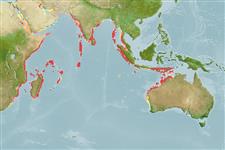Common names from other countries
Environment: milieu / climate zone / depth range / distribution range
Ecologia
marinhas associadas(os) a recifes; não migratória; intervalo de profundidade 3 - 30 m (Ref. 48391). Tropical
Eastern Indian Ocean: Sri Lanka to Western Australia, including Indonesia and the Andaman Is.
Tamanho / Peso / Idade
Maturity: Lm ? range ? - ? cm
Max length : 15.0 cm TL macho/indeterminado; (Ref. 4859)
Espinhos dorsais (total) : 14; Raios dorsais moles (total) : 14 - 16; Espinhos anais: 3; Raios anais moles: 15 - 17.
Inhabits rocky areas of seaward reefs as well as rich coral areas (Ref. 9710). Feeds on algae; forms harems of 3-7 individuals. Frequently exported through the aquarium trade. Forms hybrids with Centropyge vrolikii in areas where these 2 species are sympatric, and hybrids with the C. flavissima have been recorded in the Christmas I. and Cocos-Keeling islands in the eastern Indian Ocean. Mimicked by the juveniles of the acanthurid Acanthurus tristis (Ref. 48391).
Life cycle and mating behavior
Maturities | Reprodução | Spawnings | Egg(s) | Fecundities | Larvas
Pyle, R., 2001. Pomacanthidae: Angelfishes. p. 3266-3286. In K.E. Carpenter and V.H. Niem (eds.) FAO species identification guide for fishery purposes. The living marine resources of the Western Central Pacific. Volume 5. Bony fishes part 3 (Menidae to Pomacentridae). Rome, FAO. (Ref. 48391)
Categoria na Lista Vermelha da IUCN (Ref. 130435)
CITES (Ref. 128078)
Not Evaluated
Ameaça para o homem
Harmless
Utilização humana
Can't connect to MySQL database (fbapp). Errorcode: Too many connections
